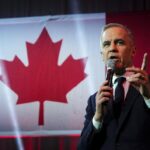Mark Carney aims to rebuild Canada-India relations, prioritizing trade, economic ties, and diplomacy after tensions escalated under Justin Trudeau’s leadership.
Canada and India have shared a long and complex diplomatic relationship, shaped by trade, cultural exchanges, and geopolitical concerns. However, tensions escalated significantly during Justin Trudeau’s tenure, reaching an all-time low in 2023 after Trudeau alleged that India was involved in the killing of Khalistani separatist Hardeep Singh Nijjar. This accusation, strongly denied by New Delhi, led to the expulsion of diplomats from both sides and a pause in trade negotiations. With Trudeau stepping down and Mark Carney set to take over as Canada’s next Prime Minister, many are watching closely to see whether he can mend ties with India and steer the relationship toward a more cooperative future.
Carney’s Approach: A Fresh Start for Canada-India Relations?
Mark Carney has expressed a clear intent to rebuild Canada’s strained relationship with India. Speaking in Calgary after his victory in the Liberal Party leadership race, he stated, “There are opportunities to rebuild relationships with India. There needs to be a shared sense of values around that commercial relationship, and if I am Prime Minister, I look forward to the opportunity to build that.”
Unlike Trudeau, who often faced criticism for his stance on issues linked to Khalistani separatists in Canada, Carney appears to be taking a more pragmatic and business-focused approach. He recognizes India as an essential economic partner and has signaled a willingness to diversify Canada’s trade partnerships with “like-minded nations.” Given India’s rapidly growing economy and global influence, improving ties could be mutually beneficial for both countries.
Read more: Mark Carney: Canada’s New Prime Minister And His Plans for the Country
Economic and Trade Relations: A Key Priority
Trade between Canada and India has historically been strong, but tensions under Trudeau disrupted progress on several economic agreements. The Early Progress Trade Agreement (EPTA), which was expected to be concluded in 2023, was put on hold following Trudeau’s allegations against India. This deal would have significantly enhanced economic collaboration between the two nations.
Carney, with his background as the former Governor of the Bank of Canada and the Bank of England, understands the economic potential of strengthening ties with India. He previously served on the board of Brookfield Asset Management, which has significant investments in India’s real estate, renewable energy, and infrastructure sectors. This experience gives him deeper insights into India’s economic landscape and the benefits of fostering stronger trade partnerships.
With his leadership, Canada may work to restart trade negotiations and expand economic ties beyond the halted EPTA. India, on the other hand, could benefit from increased Canadian investments in critical sectors like technology, clean energy, and manufacturing.
Also Read: The Canadian Dollar Hits a Low—Is a Recovery Imminent?
Immigration Policy and Visa Restrictions: A Key Concern
Another significant aspect of India-Canada relations has been immigration. Canada has long been a preferred destination for Indian students and skilled workers. However, under Trudeau, visa services for Canadian nationals were temporarily suspended, creating uncertainty among those looking to travel between the two countries.
Carney’s stance on immigration will be a crucial factor in shaping future ties. Canada recently moved to tighten its immigration policies and visa norms, which could be a point of discussion between Carney’s administration and Prime Minister Narendra Modi’s government. If relations improve, India may push for smoother visa processes for professionals, students, and business travelers.
Also Read: Canada’s Unemployment Rate Climbs to 6.8% Amid Economic Challenges
The Khalistan Factor: Can Carney Address India’s Concerns?
One of the most contentious issues between Canada and India has been the Khalistani separatist movement. India has accused Canada of allowing extremist elements to operate freely within its borders, leading to tensions between the two governments. The Nijjar case was a breaking point in 2023, leading to diplomatic fallout.
While Carney has not explicitly addressed the Khalistan issue, his overall approach seems to be more balanced compared to Trudeau. His focus on economic ties and shared values could indicate a shift away from Trudeau’s handling of the issue, potentially reassuring India that Canada will take its sovereignty concerns more seriously.
If Carney’s administration takes concrete steps to address India’s concerns—such as stronger enforcement against extremist groups—relations could see a significant improvement. However, it remains to be seen whether his short tenure before the general elections in October will allow him to make meaningful policy changes.
Geopolitical Context: Strengthening Alliances Amidst US Tariffs
Beyond bilateral issues, Canada and India also share a common challenge: dealing with the United States under Donald Trump. The former US president recently announced 25% tariffs on Canadian products, prompting Canada to impose retaliatory tariffs on $30 billion worth of US goods. India, too, has had its share of trade tensions with the US.
With Trump’s tariff threats affecting both India and Canada, there may be an opportunity for increased economic cooperation between the two nations. Strengthening trade partnerships outside the US could be mutually beneficial, particularly in sectors such as renewable energy, pharmaceuticals, and technology.
Carney’s experience in global finance could play a crucial role in shaping Canada’s trade strategy. If he successfully diversifies trade ties with India and other like-minded nations, it could reduce Canada’s reliance on the US market and create new economic opportunities.
Also Read: US-Canada Trade War Begins: Here’s All You Need To Know
What’s Next? Can Carney Deliver on His Promises?
Mark Carney’s tenure as Prime Minister is expected to last only until October 2025, when Canada holds its general elections. This short window of time limits how much he can achieve in repairing relations with India. However, his pro-trade stance, economic background, and understanding of India’s market suggest that he is at least willing to open a dialogue for reconciliation.
If India sees positive signals from Canada under Carney’s leadership, Modi’s government may consider re-engaging diplomatically. A high-level meeting between Indian and Canadian officials could set the stage for discussions on trade, immigration, and strategic partnerships. The fate of the Early Progress Trade Agreement will also be a key indicator of whether relations are moving in the right direction.
Ultimately, Carney’s success in improving Canada-India relations will depend on whether he can take concrete actions in the coming months. If he fails to make significant progress, it will likely be up to the next Canadian government after the elections to determine the long-term direction of the bilateral relationship.
Conclusion
Mark Carney’s leadership marks a potential turning point in Canada-India relations. After years of strained ties under Justin Trudeau, Carney has expressed a desire to rebuild diplomatic and economic connections with India. His business-oriented approach, experience in finance, and focus on shared values could help reset the relationship.
However, with only a short time before the elections, it remains uncertain how much progress he can make. If Carney takes decisive steps to address India’s concerns—particularly on trade and security—Canada and India could move toward a more stable and cooperative partnership. On the other hand, if key issues remain unresolved, tensions may persist, leaving the next Canadian government to shape the future of bilateral relations.
For now, all eyes are on Carney as he takes office, with hopes that his leadership will pave the way for a new and improved chapter in Canada-India relations.





